Dean &
Ginny's excellent adventures... Main
Adventure Page
Grand
Voyage--2012:
<<
Part 1 <<
Part 2 <<
Part 3 <<
Part 4 <<
Part 5 <<
Part 6 <<
Part 7 Part
8
Part
9 >>
Part
10 >>
Part
11 >>
Part
12 >>
Part 13 >>
Part 14 >>
Part 15 >>
Part 16 >>
Part 17 >>
Part 18 >>
Part 19 >>
Part 20 >>
Part 21 >>
Part 22 >>
Part 23 >>
Part 24 >>
Part 25 >>
|
|

As we sailed between the first two islands of the northernmost Antarctic
peninsula, the early morning shroud of fog was slow to reveal her
secrets...
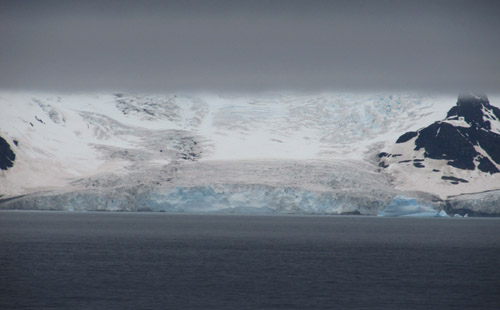

but little by little glaciers with their blue
compressed ice and snow could be seen and eventually whole mountains.
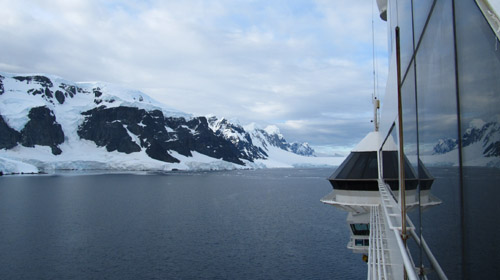

|
|


While there was a large audience in the Crows Nest, the ship opened the
outside bow area for the heartier passengers--it's normally closed to
passengers. It was 32 degrees for much of the
time we were there and the weather was calm and beautiful--an unusual
situation we were told.
|
|

Our first stop was Hope Bay, a small harbor with an Argentine base,
Esperanta. Whole families live here for the summer and there is a
school for the 35 children. It was originally started by the British, but after a fire and some deaths, they left. When they
came back two summers later, the Argentines had claimed it and when
the British tried to land, shots were fired over their bow--this is
apparently the only shots fired in anger on this continent. While
there are various claims and stations of operations, an
international treaty is in place for all.
|

|
|
We
didn't actually set foot on land, but we idled close by long enough
to take in the glaciers and the scenery. Commentary over the speaker
system pointed out the highlights.
 
|
|
 While
it looks peaceful from a distance, the place is overrun with Adele
penguins--you pronounce the final e. Their pinkish guano is colored
by their krill-laden diet. From what we heard, the smell is
quite something to experience. While
it looks peaceful from a distance, the place is overrun with Adele
penguins--you pronounce the final e. Their pinkish guano is colored
by their krill-laden diet. From what we heard, the smell is
quite something to experience.
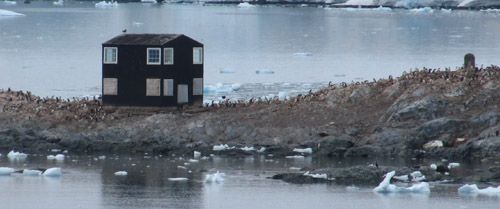
 The
penguins climbing up this large snow field are heading toward their
very high nesting area where their chicks await the next meal. At
the bottom of the hill the ones facing us (white) were ready to jump
back in the water while the black backs indicate those heading up. >> The
penguins climbing up this large snow field are heading toward their
very high nesting area where their chicks await the next meal. At
the bottom of the hill the ones facing us (white) were ready to jump
back in the water while the black backs indicate those heading up. >>
They
remind me of the die-hard human skiers I saw in another lifetime,
who were skiing Tuckerman's Ravine on the side of Mt. Washington on
a Memorial Day weekend--they'd ski down the snow in 30 seconds and
then carry their skis up to the top of the hill to do it
again. We loved watching the penguins
working out
in the water. They were fast and unpredictable so it was really hard
to get a decent photo of them. They porpoised--jumping in groups in
and out of the water's surface. Just delightful!

|
|
|
And then there were the icebergs...
|




After Hope Bay we saw increasing numbers of icebergs (We had an
ice pilot aboard to help with navigation.) Sometimes the icebergs had occupants.
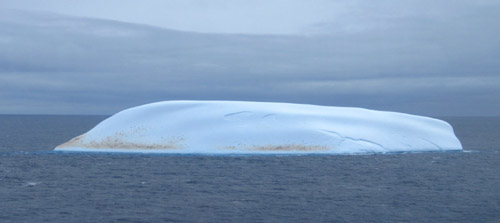

This long smooth iceberg with its stained snow, had hundreds of
penguins aboard--not for nesting, but for resting.


Penguins can jump three times their body length
from the water, but we wondered how fast they must have been
swimming to jump this high. But no penguins were seen on
icebergs with seals.
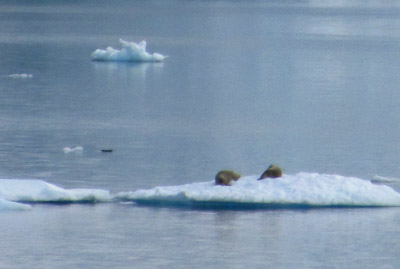


Some icebergs were bluer than others and some
developed blow holes as they melted.
|
|

|
|

We sailed around this magnificent peninsula for
three days, but we never ventured south of the Antarctic Circle
where it would have been light 24 hours a day. We saw two
other cruise ships, but they were much smaller ones that specialized in Antarctic
expeditions with only a couple of
hundred passengers each.
|
 
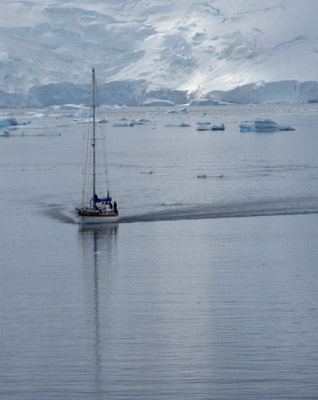 
And surprisingly a normal-looking sailboat.
|
|


On our third day here, a group of American scientists and staff
from Palmer Station boarded the Amsterdam. Palmer is a small
facility with less than one hundred people there in the
summer--McMurdo and the South Pole facilities are much larger with
more than 1,000 people in the summer.
|
|


They gave two presentations and then answered lots of questions
from the audience. I thought it was interesting that a first grade
teacher is there for the summer and she provides lessons and live
video feeds to schools all over the US. Most of Palmer Station
people returned to the station, but
since it's coming up to the end of their season, some, including
two divers, rode with us for a few days to Punta Arenas where
they'll catch flights back to the states.
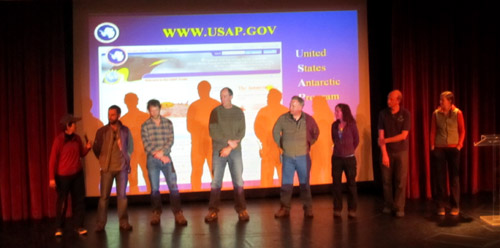
|
|
On our way north, we finally saw some whales...
The ship slowed for us when they spotted these two humpback
whales.




Those same 2 whales dived together showing us their tales. The
white parts of their bodies showed up as turquoise under the
water.
|
|


After dinner that last night when went out to
the back deck, Dean and I noted the northernmost iceberg and
experienced a magical ten minutes with a flock of cape petrels. We
were the only people out there, but we were simply entranced with
their formation acrobatics and then as a group, they sat on the
water.
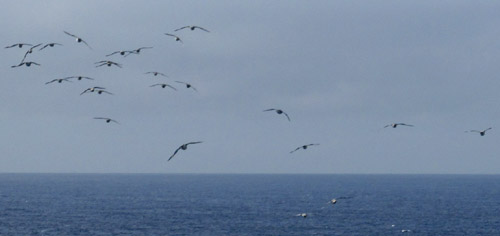

|
|

The next day Dean ran into the divers from Palmer Station
in the
ship's library and asked if they would spend some time with the
divers' group. They graciously agreed and it was arranged for that
afternoon.
They answered questions for about an hour for
about 15 of us and then showed us a six-minute video of diving
under the ice. Very cool, literally.
|
|
|
As we sailed from Antarctica across the Drake passage
toward Cape Horn and the southern tip of South America, we hit some pretty rough seas.
Many people were seasick and our Tai Chi instructor held class sitting
down.
 
Photos of the waves don't really show how rough it was, but maybe this
wave breaking across the bow and the mid-ships pool sloshing out its
water will give you some idea.
|

This TV "We are here" graphic shows
the path we took through the islands. Yellow is our track along
the Beagle Channel where Darwin's ship sailed so long ago, leads
up to Punta Arenas the southernmost city in
Chile.
|
What I had never paid attention to, is that the
western coast of southern South America consists of thousands of
islands and that Cape Horn is actually on an island. Our trip
became much smoother once we entered the Beagle Channel on the way
to Ushuaia, Argentina, the southernmost city in the world, the so
called "End of the World."

|
|
We saw this wreck and and a penguin-covered
island with a low channel marker.


|
|


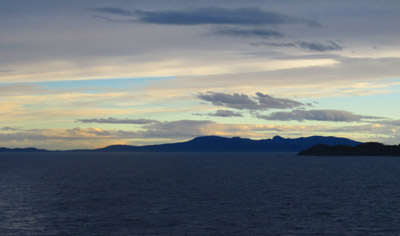
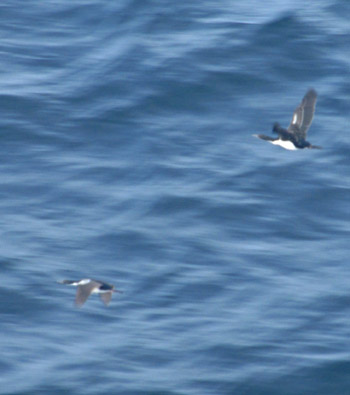
We saw these Imperial cormorants, aka blue-eyed
shags, flying with us. Sunset over the hilly islands ended the
scenery for the day. Tomorrow morning we'll be at Ushuaia.
Dean's Log:
Days 24-27
|
|











 While
it looks peaceful from a distance, the place is overrun with Adele
penguins--you pronounce the final e. Their pinkish guano is colored
by their krill-laden diet. From what we heard, the smell is
quite something to experience.
While
it looks peaceful from a distance, the place is overrun with Adele
penguins--you pronounce the final e. Their pinkish guano is colored
by their krill-laden diet. From what we heard, the smell is
quite something to experience.

 The
penguins climbing up this large snow field are heading toward their
very high nesting area where their chicks await the next meal. At
the bottom of the hill the ones facing us (white) were ready to jump
back in the water while the black backs indicate those heading up. >>
The
penguins climbing up this large snow field are heading toward their
very high nesting area where their chicks await the next meal. At
the bottom of the hill the ones facing us (white) were ready to jump
back in the water while the black backs indicate those heading up. >>








































